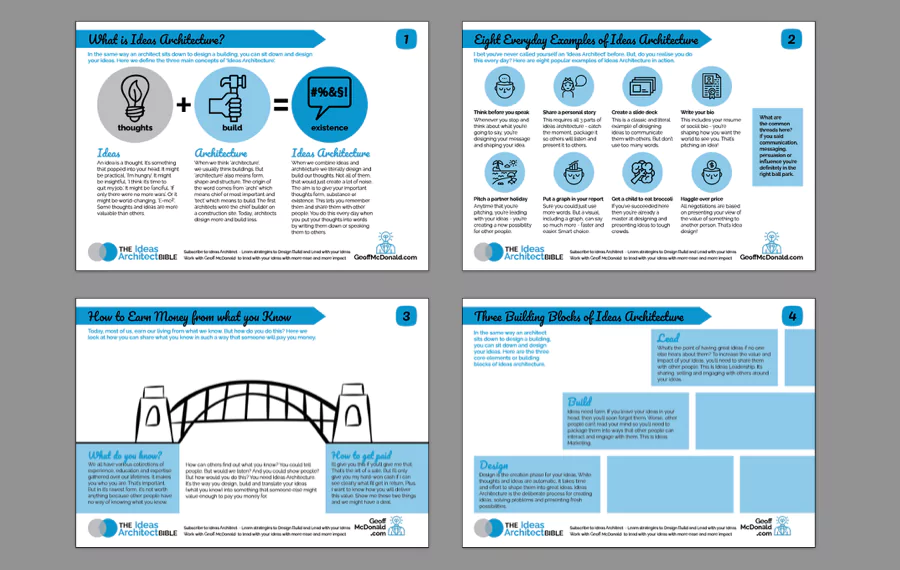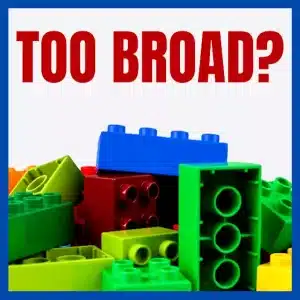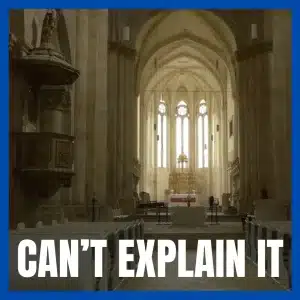What is ideas architecture? If you’ve come here to get ideas for building or creating architecture, you’ve come to the wrong place. This post is not for architects, it’s much bigger than that.
Ideas Architecture is the key to how you lead with your ideas. It’s the key to how you earn money from what you know. And it’s the key skill, the number one skill, that thought leaders, content creators, and leaders in organizations need to develop.
Ideas Architecture is something that you do every day, and you probably don’t even realize that you’re doing it. And I’ll bet you’ve never said, ‘I’m doing ideas architecture’. Unless, of course, you’re like me.
How a Networking Event Changed My Life
Have you ever had an experience where the words have just tumbled out of your mouth? And you’ve caught yourself going: ‘Did I say that? That’s pretty good’.
Well, it happened to me at a networking event about 10 years ago, someone asked me the usual question, ‘What do you do?’ And I blurted out, something that changed my life.
But thinking like that is not ideas architecture. The simplest and most common form of ideas architecture, designing your ideas, is to think about what you’re going to say before you say it. It’s being deliberate about how you communicate your ideas. And it’s the process I go through when I create posts like this one.
How I use Ideas Architecture to Create Content
1 What to write about
It starts with the topic. What do I really want to say here? And what do I want to promote? Because I want to do both. What would be valuable, useful and informative for my viewers and my current clients? Plus, what would position my expertise so I can attract new clients? And the key is to look for the overlap. You’re looking for Capital Content that both attracts new clients and serves your existing ones.
In this post, I’m talking about ideas architecture, it’s the topic of the book that I’ve just started writing The Ideas Architect Bible. And here are a couple of pages from this book (below), which was the idea behind this video.
2 Turning words into pictures
Once I have a title, I usually start on the thumbnail. How do you translate your written idea into pictures? Visuals can communicate ideas in seconds – much faster than words. Plus, you’re more likely to remember a striking image than a page full of text.
Creating a thumbnail is a simple slide. It’s like creating a billboard for your idea. What’s the essence of ideas architecture? And how do I show that as a single image?
(You can see the image I came up with on the video above)
3 Telling a good story
Next, I need to answer my five-story questions. I don’t just want to tell you a series of facts or ideas, I want to frame this as a story that goes from the progression of introducing a problem, having overcome the obstacle and finding success at the end.
Can you see this whole video is not random? There is an underlying structure and a plan to it. In the same way that you design a building – architecture, I’m designing the idea in this video, so it’s simple and clear so you can get it quickly and easily. It takes a bit of time to achieve it, but it’s worth it.
4 Writing a Script
Next, I write my script. And I know if I don’t have at least a general set of points to follow, I tend to ramble and waffle all over the place. My goal is to package this idea and share it with you in a way that triggers ideas for you. I want you to go: ‘Ah, I hadn’t thought about that. I can now do this.’ And then you’re motivated and inspired to go and act for whatever you need to do. And hopefully, it brings you better results than what you’re currently getting.
That’s the purpose of ideas, architecture, to share ideas in ways that people go ‘Clunk, got it’. But also to be excited and inspired to go ‘Now I can do this’. Plus it needs to be engaging and entertaining so your viewers will actually sit here and watch it.
5 The Mighty Metaphor and Awesome Analogy
Next, I think it needs a metaphor or an analogy. These are powerful devices for having your audience think about your idea in a fresh way. And they’re particularly useful for complex or abstract concepts – like Ideas Architecture.
The bridge from The Ideas Architect Bible page (above) is the way to go here. Ideas architect is the bridge between what you know and how to get paid for it. And that makes a great visual. I know I can get plenty of great images on bridges.
The analogy here translates the concept of ‘ideas architecture’ into an everyday example. If you simply remember that ideas architecture is like a bridge, them my effort has been successful.
And this is why it’s the key for thought leaders and content creators who want to earn money from what they know. If you can’t package up what you know, in ways that trigger interest from potential clients, then you’re going to starve. Plus, you need to be able to package and design it so you can deliver that benefit to your client so it impacts their bottom line in a positive way.
And the same applies to leaders in organizations. If you can’t share your vision of what you’re building for the future of your organization, then you’re going to be a lousy leader, and you’re just not going to get the results you want.

How I became the Ideas Architect
And that’s how I design my ideas for my videos and write these blog posts. And it all goes back to that night at the networking event when that guy asked me, ‘What do I do?’ and I blurted out, ‘Well, I used to be an architect, but I don’t design buildings anymore. I design ideas’.
That’s when I started calling myself the Ideas Architect. It sounds fancy, doesn’t it? But it’s also a literal description of my career. I used to be an architect; I have a master’s degree from a US university; I’ve practised in Australia and in the UK; I’ve presented at two of the biggest architectural conferences in the world and I’ve even written a book about the future of architecture (Beyond the Electronic Drawing Board).
But I don’t do that anymore. Nowadays, I work with speakers, authors, coaches, and trainers to help them earn money from their ideas. Instead of designing buildings now I help them create presentations, information products, write books, create intellectual property, create content, and even design board games. And this is what I mean by Ideas Architecture.
Communications, Influence and Ideas Architecture
The simplest definition of ideas architecture is the design of your ideas so that you can communicate them more effectively. It’s packaging up what you know, to influence other people.
Mostly, we talk about persuasion and influence based on words and the things we say. Ideas architecture is more specific than that. It’s designing the specific elements of your message. For instance, in this video, we’ve talked about titles and headlines. We’ve talked about thumbnails, slides and billboards. We’ve mentioned stories and anecdotes. I’ve added a visual diagram or model. And there’s a powerful metaphor or analogy in there as well.
How to Make Yourself More Valuable
The key thing I’d love for you to take away from this video is that you already do ideas architecture every day. You use it to craft an email. You use it when you add a story, an anecdote or a case study in a report or a proposal. And you use ideas architecture when you’re designing a presentation for a meeting.
But the big question here is, what would be possible for you if you could enhance your skills around ideas architecture, and the way that you design and communicate your ideas? You will become more valuable to your team, your organization and to your clients. And this is the key to earning money from what you know, but it’s also the key to the difference you can make in the communities in which you operate. If you want to expand your level of influence, then you need to develop your skills around ideas architecture.
More on Ideas Architecture and how to become a Thought Leader
If you want more on ideas architecture and how to become a thought leader then three related posts may be helpful:
- The most important thought leadership skills to develop
- Capital Content: A Daring Content Creation Idea to Double Your Results
- How to become a Thought Leader
What are your strengths and weaknesses around ideas architecture? Is it something that you do naturally or something you need to work at?






